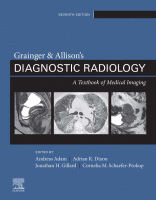Physical Address
304 North Cardinal St.
Dorchester Center, MA 02124

Introduction This chapter describes clinically important aspects of urinary tract imaging with specific reference to anatomy, techniques and radiation. We begin with an outline of urinary tract embryology in order to place urinary tract anatomy and many anatomical variations into…

Haematuria Haematuria refers to the presence of red blood cells in urine. Radiological referral of selected patients is often necessary as part of clinical management for this problem; however, the optimal method of patient selection and the best imaging algorithm…

Embryology The pancreas develops in two parts, both of which arise from the endoderm of the primitive duodenum. The dorsal part (or anlage) is the first to appear, as a diverticulum from the dorsal wall of the duodenum. This eventually…

Biliary Anatomy The intrahepatic pattern of bile duct branching is best described according to the system of Healey and Schroy, to which can be applied the Couinaud system for numbering segments. The typical pattern and its variations are shown in…

Liver Anatomy The liver has a dome-shaped superior surface following the diaphragm contours, extending anteriorly to the inferior edge of the liver. The major surface landmark is a sagittal groove containing the ligamentum teres (formerly umbilical vein), within the falciform…

Anatomy Detailed anatomical knowledge of the large intestine is fundamental to accurate image interpretation. The large bowel comprises the colon, vermiform appendix, rectum and anus. The caecum, ascending and descending colon are covered anteriorly by visceral peritoneum, whereas approximately 50%…

The Duodenum Anatomy and Normal Appearances The duodenum forms the first segment of the small bowel (SB) and measures 20–30 cm in length. The first (superior) part contains the duodenal cap (bulb) that passes superiorly, posteriorly and laterally before turning inferiorly…

Anatomy The oesophagus meets the stomach at the gastro-oesophageal (or oesophagogastric) junction (OGJ). The OGJ is formed by the lower oesophageal sphincter and the crural diaphragm, creating a barrier against acidic stomach contents. The stomach is divided into the cardia,…

Anatomy and Function Anatomy ( Table 19.1 ) The oesophagus is a fibromuscular tube that connects the pharynx in the neck to the stomach in the abdomen, traversing the thorax via the superior and posterior mediastinum. It begins below the…

In this section on abdominal imaging, the imaging approach for investigation of pathological processes of the oesophagus, stomach, small bowel, large bowel, peritoneum, liver, biliary system and pancreas are covered in their respective chapters. In this chapter, the relative merits…